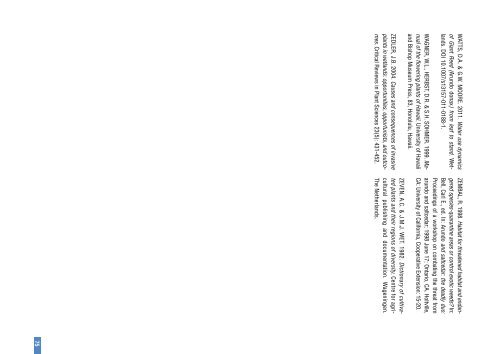final <strong>de</strong> carrera <strong>de</strong> Ciencias Ambientales.MOODY, M.E. & R.N. MACK. 1988. Controlling the spreadof plant invasions the importance of nascent foci. Journalof Applied Ecology 25: 1009-1021PAN, X.Y., GENG, Y.P., ZHANG, W.J., LI, B. & J.K. CHEN.2006. The influence of abiotic stress and phenotypicplasticity on the distribution of invasive Alternantheraphiloxeroi<strong>de</strong>s along a riparian zone. Acta Oecologica 30:333-341.4º Congreso Nacional sobre Especies Exóticas Invasoras“EEI 2012”. GEIB, Serie Técnica Nº 5. León, 218 pp.SANZ ELORZA, M., DANA SÁNCHEZ E.D. & E. SOBRINOVESPERINAS. 2004. Atlas <strong>de</strong> las plantas alóctonas invasorasen España. Ministerio <strong>de</strong> Medio Ambiente.SCOTT, G.D. 1994. Fire threat from <strong>Arundo</strong> <strong>donax</strong>. In:Jackson NE, Frandsen P and Duthoit S (eds), <strong>Arundo</strong> <strong>donax</strong>Workshop Proceedings, pp 17-18. California ExoticPest Plant Council, Riversi<strong>de</strong>.PERDUE, R.E. 1958. <strong>Arundo</strong> <strong>donax</strong> - source of musical reedsand industrial c<strong>el</strong>lulose. Economic Botany 12: 368-404.PLANTY-TABACCHI, A.M., TABACCHI, E., NAIMAN, R.J.,DEFERRARI, C. & H. DESCAMPS. 1996. Invasibility ofspecies rich communities in riparian zones. ConservationBiology 10: 598-607.POLUNIN, O. & A. HUXLEY. 1987. Flowers of the Mediterranean.Hogarth Press, London.QUINN, L.D. 2006. Ecological corr<strong>el</strong>ates of invasion by<strong>Arundo</strong> <strong>donax</strong>. Dissertation. Riversi<strong>de</strong>, CA: University ofCalifornia.QUINN, L.D. & J.S. HOLT. 2009. Restoration for resistanceto invasion by giant reed (<strong>Arundo</strong> <strong>donax</strong>). Invasive plantscience and management 2: 279-291.RICHARDSON, D.M., HOLMES, P.M., ESLER, K.J., GA-LATOWITSCH, S.M., STROMBERG, J.C., KIRKMAN, S.P.,PYSEK P & HOBBS RJ. 2007. Riparian vegetation: <strong>de</strong>gradation,alien plant invasions, and restoration prospects.Diversity and Distributions. 13, 126-139.REJMÁNEK, M. (1989). Invasibility of plant communities,a A. Drake i A. Mooney (editors) (1989). Biologicalinvasions: a global perspective, Brisbane, John Wiley &Sons, 369-388.SHARMA, K. P., S.P.S. KUSHWAHA & B. GOPAL. 1998. Acom<strong>para</strong>tive study of stand structure and standing crops oftwo wetland species, <strong>Arundo</strong> <strong>donax</strong> and Phragmites karka,and primary production in <strong>Arundo</strong> <strong>donax</strong> with observationson the effect of clipping. Tropical Ecology. 39:3-14.SORIANA, A. & O.E. SALA. 1983. Ecological strategies in aPatagonian arid steppe. Vegetatio 56: 9-15.SPENCER, D.F. & G.G. KSANDER. 2006. Estimating <strong>Arundo</strong><strong>donax</strong> ramet recruitment using <strong>de</strong>gree-day based equations.Aquatic Botany. 85:282-288.SPENCER, D.F., TAN, W., LIOW, P., KSANDER, G.G. & L.C.WHITEHAND. 2009. Evaluation of late summer ImazapyrTreatment for Managing Giant Reed (<strong>Arundo</strong> <strong>donax</strong>). Journalof Aquatic Plant Management 47: 40-43.SPENCER, D.F., WAILUN, T., P.S. LIOW, KSANDER GREG,G., WHITEHAND, L.C., WEAVER, S., OLSSON, J. & M.NEWHOUSER. 2008. Evaluation of glyphosate for managingGiant Reed (<strong>Arundo</strong> <strong>donax</strong>). Invasive Plant Scienceand Management 1: 248-254.SPENCER, D.F., KSANDER, G.G. & P.S. LIOW. 2005. Responseof giant reed (<strong>Arundo</strong> <strong>donax</strong> L.) to intermittentshading. In 45th Annual Meeting of the Aquatic Plant ManagementSociety. San Antonio, TX: Aquatic Plant ManagementSociety.74ROSSA, B. TUFFERS, A.V., NAIDOO, G. & D.J. VON WI-LLERT. 1998. <strong>Arundo</strong> <strong>donax</strong> L. (Poaceae) – a C 3specieswith unusually high photosynthetic capacity. Botanica Acta111: 216-221.SANTÍN, I., JIMÉNEZ, J., VILÁN, X.M., SÁNCHEZ, F.J. &GARCÍA, J. 2012. Efectos d<strong>el</strong> tamaño y humedad d<strong>el</strong> rizomaen la capacidad invasora <strong>de</strong> <strong>Arundo</strong> <strong>donax</strong> L. en condiciones<strong>control</strong>adas. (2012) En: GEIB Grupo Especialista en InvasionesBiológicas (ed) EEI 2012 Notas Científicas. pp. 188-189.USEPA. 1997. Control of giant cane in riparian and wetlandareas of northern and central California. Final report.VILÁN, X.M., SÁNCHEZ, F.J., GARCÍA, J., JIMÉNEZ, J. &GARCÍA-GUIJAS, J.M. 2011. Proyecto <strong>de</strong> I+D+i <strong>de</strong> Optimización<strong>de</strong> los Sistemas <strong>de</strong> Eliminación y Control <strong>de</strong> Cañaverales<strong>para</strong> Mejora d<strong>el</strong> Estado Ecológico y Recuperación<strong>de</strong> la Capacidad <strong>de</strong> Desagüe <strong>de</strong> los Ríos. En: Actas d<strong>el</strong> ICongreso Ibérico <strong>de</strong> Restauración Fluvial “Restaura Ríos”.pp. 735-743. León, 2011, España.
WATTS, D.A. & G.W. MOORE. 2011. Water use dynamicsof Giant Reed (<strong>Arundo</strong> <strong>donax</strong>) from leaf to stand. Wetlands.DOI 10.1007/s13157-011-0188-1.WAGNER, W.L., HERBST, D.R. & S.H. SOHMER. 1999. Manualof the flowering plants of Hawaii. University of Hawaiiand Bishop Museum Press, 83, Honolulu, Hawaii.ZEDLER, J.B. 2004. Causes and consequences of invasiveplants in wetlands: opportunities, opportunists, and outcomes.Critical Reviews in Plant Sciences 23(5): 431-452.ZEMBAL, R. 1998. Habitat for threatened habitat and endangeredspecies-quarantine areas or <strong>control</strong> exotic weeds? In:B<strong>el</strong>l, Carl E., ed. In: <strong>Arundo</strong> and saltcedar: the <strong>de</strong>adly duo:Proceedings of a workshop on combating the threat fromarundo and saltcedar; 1998 June 17; Ontario, CA. Holtville,CA: University of California, Cooperative Extension: 15-20.ZEVEN, A.C. & J.M.J. WET. 1982. Dictionary of cultivatedplants and their regions of diversity. Centre for agriculturalpublishing and documentation. Wageningen.The Netherlands.75


